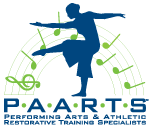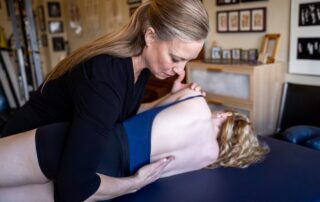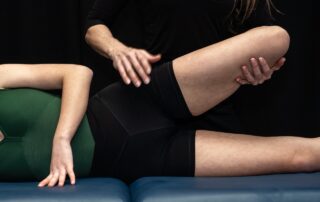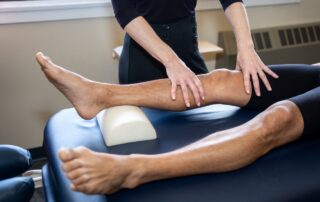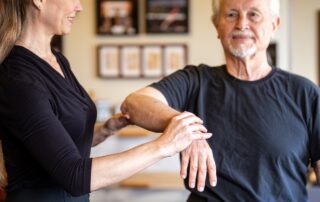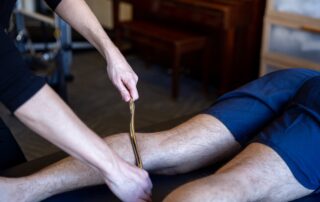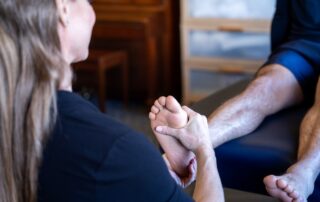Helping you feel and move better
At PAARTS, hands-on care is a cornerstone of our work. Manual therapy techniques are used to address soft tissues and joints. These techniques are intended to lessen pain, reduce inflammation, increase range of motion and reduce restriction. Hands on treatments also help to decrease edema (swelling), augment health, repair body functions and structures and to maintain and improve physical performance. Before any type of hands on treatment is performed, a full assessment of the affected area is completed. Depending on what is revealed in the assessment, specific techniques or a combination of manual therapy approaches may be performed. You can feel confident that the best manual therapy techniques for your particular condition will be selected.
Manual Therapy Techniques
Quick links
Soft Tissue Mobilization
Muscles play an important role and can impact how the joints function. If there is too much tension, there can be muscle spasm and joint dysfunction. With soft tissue mobilization, fibrous muscle tissue is broken up. This procedure is often applied to the musculature surrounding the spine, neck, upper and lower extremities. Soft tissue mobilization consists of deep pressure and rhythmic stretching. This technique is helpful in reducing pain and removing restricted movement.
Joint Mobilization
Usually, if you have a pulled muscle in the neck or back, you’re instructed to treat it with heat or ice. While these treatments may provide temporary relief, the pain soon returns. With joint mobilization, the restricted joints are loosened up through manual therapy. Based on the science of biomechanics, the joint is moved in a manner that will enhance its normal motion and in a way that the client cannot do on his/her own.
Strain-Counterstrain
This technique focuses on fixing abnormal neuromuscular reflexes that are causing painful tender points. The technique is extremely gentle and is tolerated well.
Muscle Energy Techniques
Muscle energy techniques lengthen shortened muscles and to free-up restricted joints. A gentle voluntary contraction is utilized against a controlled counterforce applied in a specific direction and position. It’s an active procedure and generally well tolerated by clients.
Myofascial Release
Myofascial Release is a safe and effective hands-on technique that utilizes gentle sustained pressure into myofascial connective tissue restrictions to eliminate pain and restore motion. This critical “time element” of this treatment technique has to do with the viscous flow and what is known as the piezoelectric phenomenon: a low load (gentle pressure) applied slowly will allow a viscoelastic medium (fascia) to elongate.
A number of tissue insults such as trauma, inflammatory responses, and/or surgical procedures create myofascial restrictions that can produce tensile pressures of approximately 2,000 pounds per square inch on pain sensitive structures that do not show up in many of the standard tests (x-rays, myelograms, CAT scans, electromyography, etc.)
At PAARTS we use Myofascial Release to assess and treat each client’s unique presentation. Our one-on-one hands-on treatments restore motion of affected tissues. Each Myofascial Release Treatment session is performed directly on skin without oils, creams or machinery. This enables the therapist to accurately detect fascial restrictions and apply the appropriate amount of sustained pressure to facilitate release of the fascia.
Graston Technique
The Graston Techniqueis a form of manual therapy known as soft-tissue instrument-assisted mobilization. It is one of a number of manual therapy approaches that usesinstruments with a specialized form of massage/scraping the skin gently. Graston Techniqueuses uniquely designed handheld instruments with a specialized form of massage that is intended to help the practitioner identify areas of restriction and break up the scar tissue. There are 6 core tools used in Graston Technique. The instruments are used to scan over and detect areas of injured fibrotic tissue.
At PAARTS, Graston Technique treatments are often rendered along the kinetic chain. A client presenting with back pain might also receive treatment to the hip flexors, abdomen, hamstrings, shoulders, and other regions of the body which often seem remote but are connected through the fascial network.
CranioSacral Therapy
CranioSacral Therapy (CST) is a gentle, hands-on method of evaluating and enhancing the functioning of a physiological body system called the craniosacral system – which encompasses the membranes and cerebrospinal fluid that surround and protect the brain and spinal cord. The technique uses a very soft touch to release restrictions in the craniosacral system to improve the functioning of the central nervous system – and thereby the entire body.
CST compliments the body’s natural healing processes. It is increasingly used as a preventive health measure for its ability to boost resistance to disease; it is effective for a wide range of medical problems associated with pain and dysfunction, including:
- Migraine Headaches
- Chronic Neck and Back Pain
- Motor-Coordination Impairments
- Colic
- Autism
- Central Nervous System Disorders
- Orthopedic Problems
- Concussions and Traumatic Brain Injuries
- Alzheimer’s and Dementia
- Spinal Cord Injuries
- Scoliosis
- Infantile Disorders
- Learning Disabilities
- Chronic Fatigue
- Emotional Difficulties
- Stress and Tension-Related Problems
- Fibromyalgia and other Connective-Tissue Disorders
- Temporomandibular Joint Syndrome (TMJ)
- Neurovascular or Immune Disorders
- Post-Traumatic Stress Disorder
- Post-Surgical Dysfunction
- Vertigo and Dizziness
- And more…
Visceral Mobilization
Visceral Mobilization (VM) assists in restoring functional and structural balance in throughout the body including musculoskeletal, vascular, nervous, urogenital, respiratory, digestive and lymphatic systems. This form of manual therapy evaluates and treats the dynamics of motion and suspension in relation to organs, membranes, fascia and ligaments. VM increases proprioceptive communication within the body, thereby revitalizing a person and relieving symptoms of pain, dysfunction, and poor posture.
At PAARTS, VM is used as an integrative approach to evaluation and treatment. VM involves assessment of the structural relationships between the viscera, and their fascial or ligamentous attachments to the musculoskeletal system. Strains in the connective tissue of the viscera can result from surgical scars, adhesions, illness, posture or injury. Tension patterns form through the fascial network deep within the body, creating a cascade of effects far from their sources for which the body will have to compensate.
Visceral Mobilization technique is based on the specific placement of gentle manual influences to encourage the normal mobility, tone and motion of the viscera and their connective tissues. These gentle techniques can potentially improve the functioning of individual organs, the systems the organs function within, and the structural integrity of the entire body.

